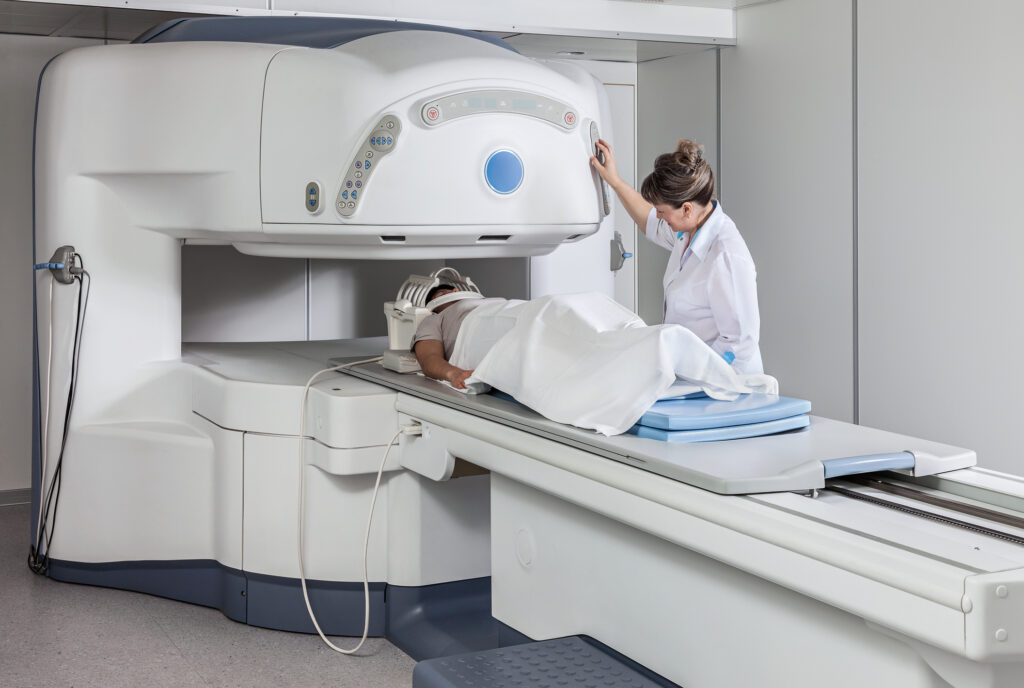Motor neurone disease (MND) is a progressive neurodegenerative disorder characterised by the degeneration of motor neurones, which leads to muscle weakness, atrophy, and eventually death. The disease is most commonly known in the form of amyotrophic lateral sclerosis (ALS), but there are several variants, each with its own set of symptoms and progression patterns. This essay explores MND, focusing on diagnostic imaging techniques, treatment options and their mechanisms, and future research directions. Diagnostic imaging plays a crucial role in identifying and differentiating MND from other neurological disorders. Current treatment strategies primarily aim to manage symptoms and slow disease progression, although significant advances are needed to develop curative therapies. The future of MND research is promising, with various emerging theories and potential therapeutic approaches being explored.
Introduction to Motor Neurone Disease
Motor neurone disease (MND) encompasses a group of neurodegenerative disorders that selectively affect motor neurones, the nerve cells responsible for controlling voluntary muscles. The most common and severe form of MND is amyotrophic lateral sclerosis (ALS), which affects both upper and lower motor neurones. Other forms include progressive muscular atrophy (PMA), primary lateral sclerosis (PLS), and progressive bulbar palsy (PBP). MND leads to muscle weakness, paralysis, and, ultimately, respiratory failure, which is the primary cause of death in affected individuals.
Pathophysiology of Motor neurone disease
MND is characterised by the degeneration of motor neurones in the brain, brainstem, and spinal cord. The precise cause of this neuronal death remains largely unknown, though genetic and environmental factors are believed to contribute. Mutations in several genes, such as SOD1, TARDBP, FUS, and C9orf72, have been implicated in familial forms of MND. These genetic mutations can lead to toxic protein aggregation, oxidative stress, mitochondrial dysfunction, and impaired axonal transport, all of which contribute to motor neurone degeneration.
Diagnostic Imaging in MND
Diagnostic imaging plays a vital role in the assessment and management of MND. While there is no single definitive test for MND, imaging techniques can help rule out other conditions that mimic MND and can provide insights into disease progression.
Magnetic Resonance Imaging (MRI)
MRI is the most commonly used imaging modality in the diagnosis of MND. It is particularly useful for excluding other neurological conditions, such as multiple sclerosis, tumours, and structural abnormalities that could cause similar symptoms. MRI can reveal hyperintensities in the corticospinal tracts, which are indicative of upper motor neurone involvement in ALS. Advanced MRI techniques, such as diffusion tensor imaging (DTI) and functional MRI (fMRI), can detect microstructural changes in the motor cortex and corticospinal tracts, offering potential biomarkers for early diagnosis and disease monitoring.
Positron Emission Tomography (PET)
PET imaging, often combined with computed tomography (CT), is increasingly being used in MND research and diagnosis. PET can measure metabolic activity in the brain, and studies have shown reduced glucose metabolism in the motor cortex and other brain regions in MND patients. PET imaging with radiolabelled ligands targeting neuroinflammation or protein aggregates, such as tau or TDP-43, is an emerging area of interest that may provide additional insights into the pathophysiology of MND.
Transcranial Magnetic Stimulation (TMS)
TMS is a non-invasive technique for assessing the functional integrity of the motor cortex and corticospinal tract. It measures motor-evoked potentials (MEPs) in response to brain magnetic stimulation, providing information on the excitability and connectivity of motor pathways. In MND, TMS often shows reduced cortical excitability, which correlates with disease severity and progression.
Ultrasound Imaging
Muscle ultrasound is a useful tool for assessing muscle atrophy and fasciculations in MND. It is non-invasive, cost-effective, and easily accessible, and it can complement other diagnostic tests. While ultrasound is not typically used to diagnose MND, it can be valuable in monitoring disease progression, especially in patients who cannot undergo MRI.
Treatment Options for Motor neurone disease
Currently, there is no cure for MND, and treatment focuses on managing symptoms, improving quality of life, and slowing disease progression. Therapeutic strategies can be broadly classified into pharmacological treatments, non-pharmacological interventions, and supportive care.
Pharmacological Treatments
Riluzole
Riluzole is the only drug approved by regulatory agencies such as the FDA and EMA for the treatment of ALS. It is believed to work by inhibiting glutamate release, thereby reducing excitotoxicity, a process that contributes to motor neurone death. Clinical trials have shown that riluzole can extend survival by several months, though its impact on quality of life is limited.
Edaravone
Edaravone is another drug that has been approved for the treatment of ALS in several countries. It is an antioxidant that helps reduce oxidative stress, which is implicated in the pathogenesis of MND. Edaravone is administered intravenously and has been shown to slow functional decline in some ALS patients, particularly in the early stages of the disease.
Antisense Oligonucleotides (ASOs)
ASOs are a promising class of drugs that target specific genetic mutations associated with MND. For example, tofersen, an ASO targeting the SOD1 mutation, has shown promise in clinical trials. ASOs work by binding to the mRNA of the target gene, leading to its degradation or preventing the production of the toxic protein. This targeted approach holds significant potential for treating familial forms of MND.
Non-Pharmacological Interventions
Physical Therapy
Physical therapy plays a crucial role in managing the symptoms of MND. It focuses on maintaining mobility, preventing contractures, and reducing pain. Stretching exercises, aerobic activities, and strength training can help maintain muscle function and improve overall well-being.
Respiratory Support
Respiratory failure is the leading cause of death in MND patients. Non-invasive ventilation (NIV) is commonly used to support breathing in the later stages of the disease. NIV can improve survival and quality of life by alleviating symptoms such as breathlessness, fatigue, and sleep disturbances. In more advanced cases, invasive ventilation may be considered, though it involves ethical considerations and discussions about the patient’s wishes.
Nutritional Support
Dysphagia, or difficulty swallowing, is a common symptom of MND, leading to weight loss and malnutrition. Nutritional support, including the use of gastrostomy tubes, is essential to ensure adequate caloric intake and maintain weight. Speech and language therapists can also provide strategies to manage dysphagia.
Supportive Care
Supportive care is a vital component of MND management, focusing on improving the quality of life for both patients and their families. This includes palliative care, psychological support, and social services. Multidisciplinary care teams, including neurologists, physiotherapists, occupational therapists, speech and language therapists, dietitians, and social workers, work together to address the complex needs of MND patients.
Mechanisms of Action of Current Treatments
Understanding the mechanisms of action of current treatments is crucial for developing more effective therapies. Riluzole’s ability to inhibit glutamate release and reduce excitotoxicity helps protect motor neurones from premature death. Edaravone’s antioxidant properties reduce oxidative stress, which is a key factor in the pathogenesis of MND. ASOs work by targeting specific genetic mutations, offering a precision medicine approach that holds promise for treating hereditary forms of the disease.
Future Research and Emerging Theories
The future of MND research is focused on uncovering the underlying mechanisms of the disease and developing novel therapeutic approaches. Emerging theories and research areas include gene therapy, stem cell therapy, and the role of neuroinflammation in MND.
Gene Therapy
Gene therapy is a rapidly evolving field that holds great promise for treating MND. Techniques such as CRISPR-Cas9 gene editing and viral vector-mediated gene delivery are being explored to correct genetic mutations or deliver therapeutic genes to motor neurones. Gene therapy could potentially halt or even reverse the progression of MND, particularly in cases with known genetic mutations.
Stem Cell Therapy
Stem cell therapy is another promising area of research. Stem cells have the potential to differentiate into motor neurones or support cells, such as astrocytes, that could help protect existing motor neurones from degeneration. Clinical trials are ongoing to assess the safety and efficacy of stem cell transplantation in MND patients. While the results have been mixed so far, advancements in stem cell technology and delivery methods may improve outcomes in the future.
Neuroinflammation and Immunomodulation
Neuroinflammation is increasingly recognised as a contributing factor in MND pathogenesis. Microglia, the brain’s resident immune cells, become activated in MND and may contribute to motor neurone damage. Targeting neuroinflammation with immunomodulatory drugs or therapies that modulate microglial activity is an area of active research. Understanding the role of the immune system in MND could lead to novel treatments that slow or stop disease progression.
Protein Aggregation and Misfolding
Abnormal protein aggregation is a hallmark of MND, particularly in ALS, where proteins such as TDP-43 form toxic aggregates within motor neurones. Research is focused on understanding the mechanisms of protein aggregation and misfolding, as well as developing therapeutic strategies to prevent or clear these aggregates. Several approaches are being explored, including small molecules that enhance protein degradation pathways, such as the ubiquitin-proteasome system or autophagy, and immunotherapy targeting misfolded proteins. The goal is to reduce the toxic burden on motor neurones and slow the progression of the disease.
6.5 Neurotrophic Factors
Neurotrophic factors are proteins that support the survival, growth, and differentiation of neurons. Research is ongoing to investigate their potential as a treatment for MND. For instance, brain-derived neurotrophic factor (BDNF) and glial cell line-derived neurotrophic factor (GDNF) have been studied for their ability to protect motor neurons from degeneration. Delivering these factors to the affected areas of the nervous system using viral vectors or stem cell-based delivery systems is being explored as a therapeutic strategy.
Biomarkers for Early Diagnosis and Monitoring
One of the significant challenges in MND research is the lack of reliable biomarkers for early diagnosis and disease monitoring. Identifying biomarkers that can detect MND at an early stage, before significant motor neurone loss has occurred, could improve the effectiveness of treatments. Research is focused on discovering biomarkers in blood, cerebrospinal fluid (CSF), and imaging that reflect the underlying disease processes, such as neuroinflammation, protein aggregation, and axonal degeneration. These biomarkers could also help stratify patients for clinical trials and monitor treatment responses.
The Role of Non-Motor Symptoms
Traditionally, MND has been viewed as a disease primarily affecting motor neurones, but there is growing recognition that non-motor symptoms, such as cognitive and behavioural changes, are also part of the disease spectrum. These symptoms can include frontotemporal dementia (FTD), which occurs in a subset of MND patients. Understanding the mechanisms behind these non-motor symptoms and their relationship to motor neurone degeneration is a key area of research. This knowledge could lead to more comprehensive treatment strategies that address both motor and non-motor aspects of the disease.
Lifestyle and Environmental Factors
While genetics play a significant role in MND, lifestyle and environmental factors are also believed to contribute to the disease. Research into these factors, such as physical activity, diet, and exposure to toxins, is ongoing. Understanding how these factors influence the risk and progression of MND could lead to new prevention strategies and therapeutic interventions.
Current Clinical Trials and Experimental Treatments
Several clinical trials are underway to test new treatments and interventions for MND. These trials are exploring a wide range of approaches, including novel drug candidates, gene therapies, stem cell therapies, and combinations of existing treatments. Some experimental treatments are focused on modifying disease progression, while others aim to improve patients’ quality of life.
Gene Editing and Antisense Oligonucleotides
Gene editing technologies like CRISPR-Cas9 and ASOs are at the forefront of MND research. Clinical trials testing ASOs for specific genetic mutations, such as tofersen for SOD1 mutations, are showing promise. These therapies aim to reduce the production of toxic proteins and slow disease progression. As gene editing techniques become more refined, they may offer a more precise and long-lasting treatment option for MND.
Stem Cell-Based Therapies
Several clinical trials are testing the safety and efficacy of stem cell transplantation in MND patients. These trials involve the transplantation of various types of stem cells, including mesenchymal stem cells, neural progenitor cells, and induced pluripotent stem cells (iPSCs). The goal is to replace lost motor neurones or provide trophic support to remaining neurones. While the results have been variable, these trials are critical for determining the potential of stem cell therapies in MND.
Small Molecule Therapies
Researchers are also exploring small molecules that target various pathological processes in MND, such as oxidative stress, mitochondrial dysfunction, and protein aggregation. For example, clinical trials are testing the efficacy of drugs that enhance autophagy, a cellular process that removes damaged proteins and organelles. These therapies aim to reduce the toxic burden on motor neurones and preserve their function.
Immunotherapy
Immunotherapy, which has revolutionised cancer treatment, is being investigated as a potential treatment for MND. Researchers are exploring whether modulating the immune system can protect motor neurones from degeneration. This includes strategies to target neuroinflammation, reduce microglial activation, and prevent immune-mediated damage to motor neurones. Clinical trials are ongoing to test the safety and efficacy of various immunomodulatory drugs in MND patients.
Challenges and Limitations in MND Research
Despite the progress being made in MND research, several challenges and limitations remain. One of the main challenges is the heterogeneity of the disease. MND presents with a wide range of symptoms, progression rates, and underlying causes, making it difficult to develop a one-size-fits-all treatment. This variability also complicates clinical trials, as it can be challenging to measure the effectiveness of a treatment across a diverse patient population.
Another significant challenge is the lack of biomarkers for early diagnosis and disease monitoring. Without reliable biomarkers, it is difficult to detect MND before significant motor neurone loss has occurred or to measure the impact of a treatment accurately. The development of such biomarkers is a high priority in current research efforts.
The blood-brain barrier (BBB) is another obstacle in the treatment of MND. The BBB protects the brain from harmful substances in the blood but also prevents many potentially beneficial drugs from reaching the brain and spinal cord. Overcoming the BBB to deliver therapeutic agents to motor neurones is a significant challenge in developing effective treatments for MND.
Finally, the slow and unpredictable progression of MND complicates the design and interpretation of clinical trials. Because MND progresses at different rates in different patients, it can be difficult to determine whether a treatment is effective. This variability necessitates long and large-scale clinical trials, which are costly and time-consuming.
Ethical Considerations in MND Research and Treatment
Research and treatment of MND raise several ethical considerations, particularly regarding experimental therapies and end-of-life care. The progressive and terminal nature of MND leads many patients to consider experimental treatments, some of which may carry significant risks. Informed consent is crucial, and patients must be fully aware of the potential benefits and risks of any experimental therapy.
End-of-life care for MND patients is another area where ethical considerations are paramount. Decisions about invasive ventilation, feeding tubes, and palliative care must be made with respect for the patient’s autonomy and wishes. These decisions often involve complex discussions between patients, families, and healthcare providers.
The Future of MND Research
The future of MND research is promising, with several avenues of investigation offering hope for new treatments and, eventually, a cure. Advances in gene editing, stem cell technology, and our understanding of the molecular mechanisms underlying MND are likely to lead to new therapeutic strategies. Collaborative efforts between researchers, clinicians, and patients are essential to drive progress and translate research findings into effective treatments.
As research progresses, the focus is shifting towards personalised medicine, where treatments are tailored to the specific genetic and molecular characteristics of each patient’s disease. This approach has the potential to improve outcomes and offer more targeted and effective therapies.
In addition, the development of reliable biomarkers for early diagnosis and disease monitoring will be crucial in advancing MND research and treatment. Such biomarkers would enable earlier intervention, better stratification of patients in clinical trials, and more accurate assessment of treatment efficacy.
Conclusion
Motor neurone disease remains a devastating and incurable condition, but significant progress is being made in understanding its underlying mechanisms and developing new treatments. Diagnostic imaging, particularly MRI and PET, plays a crucial role in the diagnosis and management of MND, while treatments like riluzole and edaravone provide some benefit in slowing disease progression.
The future of MND research holds promise, with emerging therapies such as gene editing, stem cell transplantation, and immunotherapy offering hope for more effective treatments. However, challenges such as disease heterogeneity, the lack of biomarkers, and ethical considerations must be addressed to advance the field.
Ultimately, continued research and collaboration across disciplines will be essential to unlock new insights into MND and improve the lives of those affected by this relentless disease. While a cure may still be on the horizon, the advancements in research and treatment strategies provide hope for better management and, eventually, prevention of motor neurone disease.
Q&A on Motor Neurone Disease
Q1: What is Motor Neurone Disease (MND)?
A1: Motor neuron disease (MND) is a progressive neurodegenerative disorder that affects motor neurons, leading to muscle weakness, paralysis, and eventually respiratory failure.
Q2: What are the common types of MND?
A2: The most common types of MND include Amyotrophic Lateral Sclerosis (ALS), Progressive Muscular Atrophy (PMA), Primary Lateral Sclerosis (PLS), and Progressive Bulbar Palsy (PBP).
Q3: How is MND diagnosed through imaging?
A3: MND is often diagnosed using MRI to rule out other conditions, with advanced imaging techniques like diffusion tensor imaging (DTI) providing detailed views of motor neuron damage.
Q4: What treatments are currently available for MND?
A4: Treatments for MND include drugs like Riluzole and Edaravone, which slow disease progression, as well as supportive therapies like physical therapy, respiratory support, and nutritional care.
Q5: What are the future research directions for MND?
A5: Future research in MND focuses on gene therapy, stem cell therapy, neuroinflammation modulation, and developing biomarkers for early diagnosis and treatment monitoring.
Q6: What role do neuroinflammation and protein aggregation play in MND?
A6: Neuroinflammation and protein aggregation contribute to motor neuron damage in MND, with research exploring ways to target these processes to slow disease progression.
Disclaimer
The information presented in this article is intended for general educational and informational purposes only. It is not a substitute for professional medical advice, diagnosis, or treatment. Open Medscience and the authors of this content do not provide medical, clinical, or therapeutic services or advice, and no doctor–patient relationship is created by accessing or using this content.
Motor neurone disease (MND) is a complex and serious medical condition, and individual cases vary greatly. Always seek the guidance of a qualified healthcare professional with any questions you may have regarding a medical condition or treatment options. Do not disregard professional medical advice or delay seeking it because of something you have read in this article.
Any mention of specific treatments, diagnostic tools, ongoing research, or future therapies is for informational purposes only and does not constitute endorsement or recommendation. Clinical trials and emerging therapies should only be considered in consultation with a licensed medical professional.
Open Medscience does not accept responsibility for any loss or damage that may arise from reliance on information contained in this article. Readers are encouraged to consult primary sources and peer-reviewed research where appropriate.
You are here: home » diagnostic medical imaging blog »



